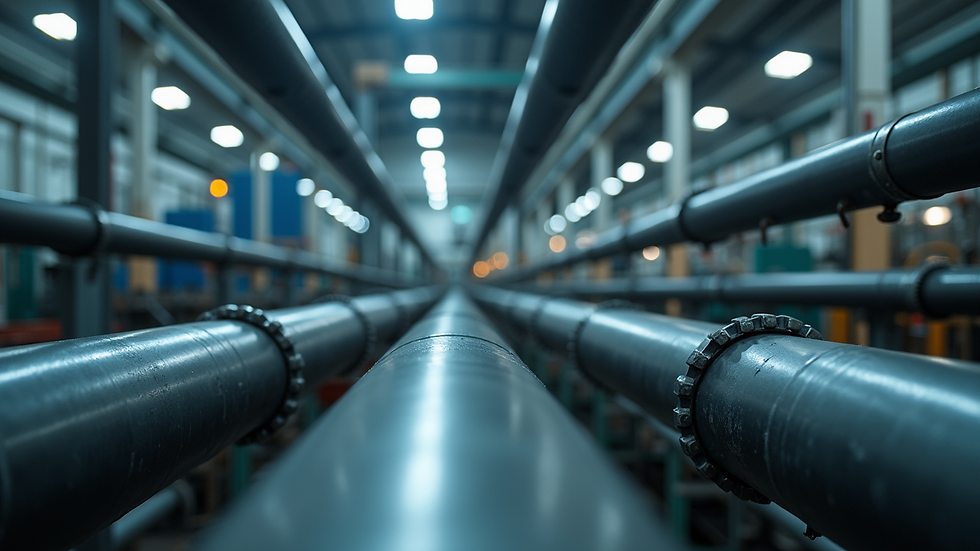Essentials of Process Piping Installation
- Thomas Precision Welding

- 7 minutes ago
- 4 min read
When it comes to industrial projects, the quality and precision of piping installation can make or break the entire operation. We know that every detail counts, from the choice of materials to the final welds. Industrial piping installation is a complex task that demands expertise, planning, and the right tools. Today, we’ll walk through the essentials you need to understand to ensure your piping systems are installed efficiently and safely.
Understanding Industrial Piping Installation
Industrial piping installation involves assembling pipes, fittings, valves, and other components to create a system that transports fluids or gases. This process is critical in industries such as chemical processing, food and beverage, pharmaceuticals, and energy production. The goal is to build a system that is durable, leak-proof, and compliant with safety standards.
We start by selecting the right materials. Stainless steel, carbon steel, and aluminum are common choices, each with unique properties suited to different environments. For example, stainless steel is excellent for sanitary applications due to its corrosion resistance and ease of cleaning.
Next, we focus on layout and design. Proper planning ensures that pipes are routed efficiently, minimizing pressure drops and avoiding unnecessary bends. This step also considers future maintenance access and expansion possibilities.
Finally, the installation itself requires skilled welders and fabricators who understand the nuances of joining metal components. Precision welding and fitting are essential to prevent leaks and ensure system longevity.

Key Steps in Industrial Piping Installation
To achieve a successful installation, we follow a structured approach:
Site Preparation
Clear the area and ensure all necessary tools and materials are on hand. This reduces downtime and keeps the project on schedule.
Material Inspection
Check all pipes and fittings for defects or damage before installation. This step prevents costly rework later.
Cutting and Fitting
Pipes must be cut to precise lengths and fitted together accurately. Using templates or CAD drawings helps maintain consistency.
Welding and Joining
Skilled welders perform the joining process, adhering to industry standards such as ASME or API codes. Proper welding techniques ensure strong, leak-proof joints.
Testing and Inspection
After installation, pressure tests and inspections verify the integrity of the system. Any leaks or weaknesses are addressed immediately.
Documentation and Handover
Detailed records of materials, welds, and tests are compiled for future reference and compliance purposes.
Throughout these steps, safety is paramount. We always use personal protective equipment and follow OSHA guidelines to protect workers and the environment.
What is the process of installing water pipes?
Installing water pipes in an industrial setting requires careful attention to both design and execution. The process typically begins with a thorough site survey to understand the water demand and pressure requirements.
We then select pipe materials suitable for potable water or process water, often opting for stainless steel or copper due to their durability and resistance to contamination.
The installation process includes:
Trenching or routing: Creating pathways for underground or above-ground pipes.
Pipe laying: Positioning pipes according to the design, ensuring proper slope for drainage if necessary.
Joining pipes: Using welding, soldering, or mechanical fittings depending on the material.
Pressure testing: Confirming the system can handle operational pressures without leaks.
Insulation and protection: Applying insulation to prevent heat loss or freezing and protecting pipes from physical damage.
Attention to detail during each phase ensures a reliable water supply system that meets regulatory standards and operational needs.

Common Challenges and How to Overcome Them
Industrial piping installation is not without its challenges. Here are some common issues and practical solutions:
Corrosion and Material Degradation
Choose corrosion-resistant materials and apply protective coatings. Regular maintenance and inspections help catch early signs of wear.
Alignment Issues
Use laser alignment tools and precise measuring equipment to ensure pipes fit perfectly. Misalignment can cause stress and leaks.
Welding Defects
Employ certified welders and conduct non-destructive testing (NDT) such as X-rays or ultrasonic inspections to detect flaws.
Tight Deadlines
Plan meticulously and maintain clear communication among teams. Prefabrication of pipe sections off-site can speed up installation.
Safety Hazards
Implement strict safety protocols, conduct regular training, and ensure all workers use appropriate PPE.
By anticipating these challenges, we can mitigate risks and deliver a piping system that performs reliably over time.
Why Choose Professional Process Piping Installation Services?
When you need precision and reliability, professional process piping installation services make all the difference. Experts bring experience, specialized equipment, and a deep understanding of industry standards to every project.
Partnering with professionals means:
Customized Solutions tailored to your specific operational needs.
Compliance with Codes and Regulations ensuring safety and legal adherence.
Efficient Project Management reducing downtime and controlling costs.
High-Quality Fabrication and Welding for long-lasting performance.
Comprehensive Testing and Documentation providing peace of mind.
Investing in expert installation not only safeguards your operations but also enhances your facility’s reputation for quality and safety.
Enhancing Your Facility with Expert Piping Installation
Industrial piping installation is a critical component of any manufacturing or processing facility. By focusing on quality materials, skilled workmanship, and thorough testing, we create systems that stand the test of time.
Whether you’re upgrading existing infrastructure or building new facilities, remember that the right installation approach can save you time, money, and headaches down the road. Let’s work together to build piping systems that support your business goals and operational excellence.
If you want to learn more about how professional piping installation can benefit your projects, don’t hesitate to reach out to trusted experts who specialize in custom metalwork, welding, and fabrication.





Comments